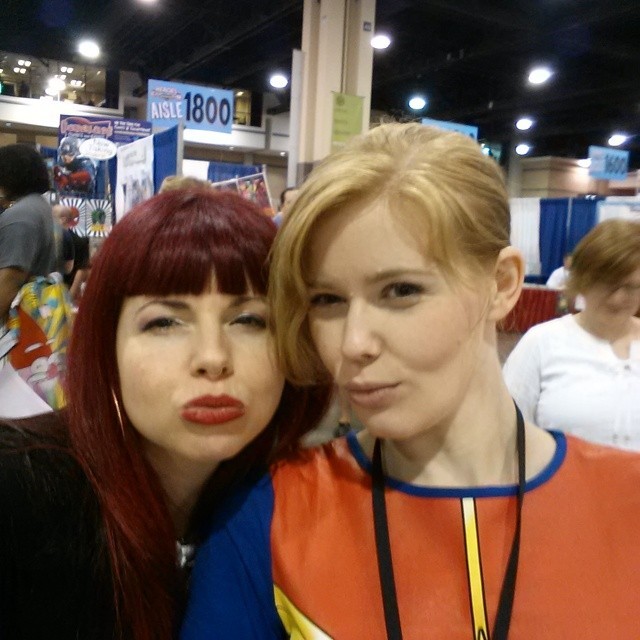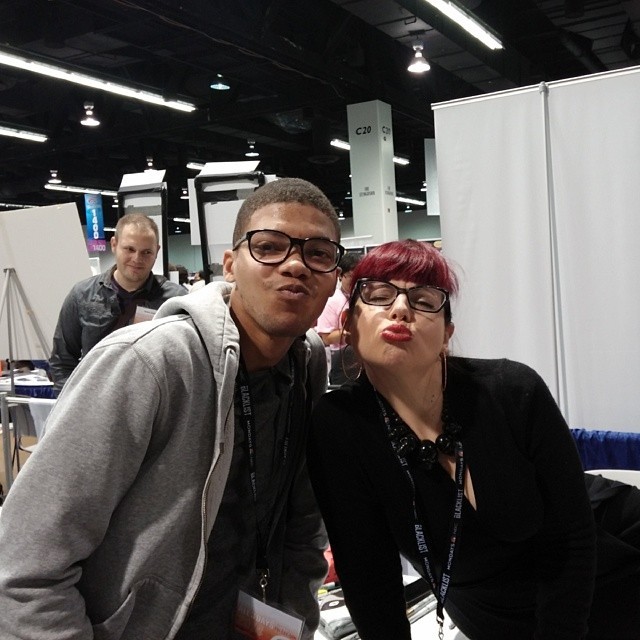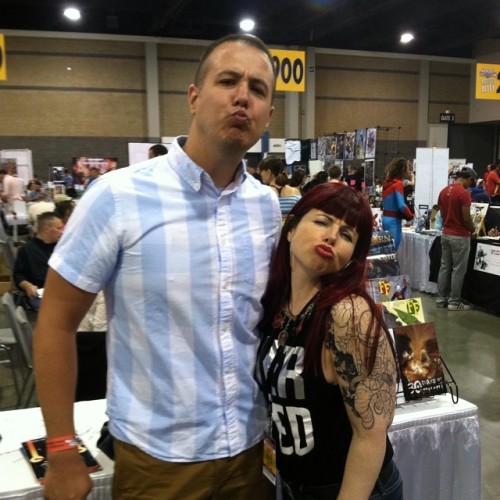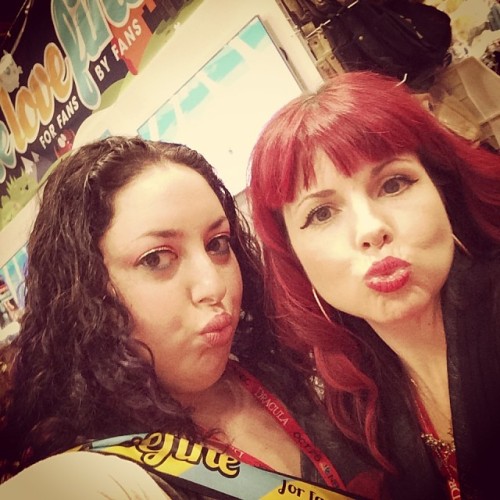I’m guessing there’s some old cliche about teaching or coaching or hosting or interviewing that consists of the sentiment of loosely setting up a scenario or environment and then getting the hell out of the way. However that phrase works, that’s how I felt about 30 seconds after getting Kelly Sue’s answers to our questions. There’s a lot of really interesting people in the comic book industry, but Kelly Sue is both interesting and hugely important as a prominent voice in an industry that could always use more evolving. The writer of comics such as AVENGERS ASSEMBLE, CAPTAIN MARVEL and PRETTY DEADLY, Kelly Sue is one half of the superhero writing duo with her husband Matt Fraction and probably owner of the best collaborative selfies in the game. I could’ve spent a week straight asking her questions, but I think this interview still gives us plenty. I hope you enjoy this as much as I did. –W.E.
Black Nerd Problems: Pretty Deadly reads and looks like nothing else currently on the shelf. I’ve noticed that with a lot of creator owned books, that the creative teams typically use that freedom for the content of their narrative. In addition to being a mature story, there is so much innovation with the style and method of storytelling in Pretty Deadly as well. It reminds me of the show Deadwood a little in how it has this brutal and unforgiving (western) motif while being paired with this beautiful prose and arrangement.
Kelly Sue DeConnick: Wow. Thank you.
BNP: What inspired you to create this world and story?
Kelly Sue: Emma Ríos.
After working with her on Osborn, I wanted to work with her again — preferably on something creator-owned. Asking her if she’d be down felt a little like asking her to prom — but she was. So I started by pitching her a grifter tale that she wasn’t really into. She proposed a western and we built Pretty Deadly from there.
The mythic aspect came in later — it was originally intended to be a very straight-forward kind of thing, but it didn’t start to feel “right” until we let the monsters in.
BNP: With Emma Ríos and company providing some amazing art in this book, did that dictate some of the style choices in the storytelling or did you have that vision when conceptualizing the story and characters?
Kelly Sue: It’s an incredibly collaborative book. We actually work a scene at a time so that we’re in constant dialogue.
We knew from the start that we wanted to let the mystery out slowly. I don’t think I realized how frustrating that would be for some readers over 3 months. In retrospect, the book reads better in trade. But that said, I don’t think it’s healthy to start reverse-engineering and trying to write for someone else. I know it’s all on the page because I’ve read some very thorough explications where folks have laid it all out. They got it, so it’s all there. But you do have to work for it a bit and I get that that isn’t going to be appealing to everyone. That’s okay. Every book doesn’t have to be for every person.
And you know, I was just talking to somebody from CBR about this yesterday in an interview about Barbarella — I think there are things about each of us that characterize our work that we probably can’t escape, but the goal for me is to approach every project as a unique experience. Avengers Assemble and Pretty Deadly are about as different as any two books could be, but I’m very proud of both of them.
BNP: One of the coolest things I’ve seen in the comic book community was the Carol Corps campaign on social media that seemed to begin when Captain Marvel #1 was released this year. It wasn’t just that countless people on Tumblr and twitter were taking selfies with your comic book, but that there were so many men, women, people of color, etc. that were getting behind and supporting a comic book with a female protagonist. It also seems that Ginny from Pretty Deadly has become a cosplay favorite. I know social media has re-calibrated all of our expectations for the support and visibility of various projects, but how would you describe the support and excitement for your work overall in the way fans have engaged you?
Kelly Sue: I have been very, very lucky.
I don’t know how to characterize it other than that.
I’m a genuine extrovert, so I love to meet people and social media can be a real joy for me, but there is an inherent danger — something I touched on above. I think you have to be careful that you don’t start writing for approval. You have to write for yourself, your collaborator and your editor. That’s it. You can’t pander or the work will suffer. The experience will suffer too, because you just can’t control how people react to your work or at what point they’re going to tire of you. You have to write for yourself first.
BNP: As you know, I wrote an article concerning the first arc of this Captain Marvel book, assessing that you, with a superhero that was a White Woman, went against the very popular trope of her coming in to save the indigenous people with little regard for the people themselves. I wrote that column before the last issue released which actually seems to make President Elianides, the leader of the Nowlian, just as much the hero of that conflict as Carol was. What compelled you to write the story this way?
Kelly Sue: Having her sweep in and punch the problem wasn’t very compelling to me. Carol’s powers are very physical, so I like to challenge her with things she can’t punch. And, I don’t know, I don’t think that I was consciously thinking of the avoiding the White Savior trope, just writing what was interesting to me.

I’ve heard from a few folks who didn’t like the arc because they didn’t think that Carol was heroic enough, and you know, that’s fine, everybody’s entitled to their opinion, but I didn’t want to write a story I’d read a bazillion times. And I wanted Carol to be wrong. I think that’s one of the things about her that is most admirable — she’s willing to be wrong and to move on from it. That’s brave.
BNP: When you and the rest of the creative team took over writing Carol Danvers’ story in 2012, not only did she get the new title of Captain Marvel, a new hairstyle and some pants, but she also got toned down quite a bit anatomically. We’re starting to see this more with other popular female heroes like Batgirl, She-Hulk, etc. Do you think the comic book industry is going to continue moving towards bringing these heroes into more realistic body types and therefore more relatable to women readers across the board?
Kelly Sue: I don’t know. We’ll see. It’ll come down to whether it ends up being a boon to them financially. It’s all market driven. Have you read about targeted marketing? It’s heartbreaking. But then there’s this thing called “disruptive innovation” that I’m pinning my hopes on.
I think that with the exponential growth of digital comics sales, publishers are starting to see that maybe actively excluding half the marketplace isn’t a great long-term strategy.
Will it pay off? I don’t know. I hope so.
BNP: What significance is there in that kind of change?
Kelly Sue: The social implications of moving away from the notion of the straight white male as the default human being are game-changing. I’m given to hyperbole and I don’t even have the language to stress how big of a deal this is and what the cultural implications of the growth of that shift could be.
BRING IT.
BNP: Have you or the creative team gotten any flack over Carol NOT bursting out of her costume anymore?
Kelly Sue: Oh sure. And I try to be gracious about it, but at some point it’s like… yeah, well? You don’t like it? So don’t buy it. There’s no shortage of ass shots on the shelves, go buy a different one. I don’t give a fuck about your boner.
BNP: I came across something online that said you edited Mangas for English publication. How did you get into doing that?
Kelly Sue: It’s a long story, but basically, Neil Gaiman had been kind enough to let me make a couple of research phone calls for him when he was working on American Gods. [quote_right]The social implications of moving away from the notion of the straight white male as the default human being are game-changing.[/quote_right]I then told pretty much everyone I know that I had “worked with Neil Gaiman” — including Jamie S. Rich, who was doing a lot of adaptation work for Tokyopop at the time. When they were looking for someone to do Demon Diary, they wanted a “Princess Mononoke feel” and Jamie volunteered that I had, ehem, “worked with Neil Gaiman.” That was enough to get me a try out, which got me the gig. From there, work begets work.
BNP: Are there any characteristics or techniques that you’ve seen in Manga that may have influenced you in anyway?
Kelly Sue: I get asked this question a lot and I’m not sure I’m the best person to do that analysis. I can’t be objective about my own work.
The only thing that springs to mind is that I do sometime call for balloons that have nothing in them but punctuation, which is very common in Japanese comics, but somewhat rare in American comics. Not exactly an Earth-shattering realization.
BNP: Any favorites of yours that you would suggest to Manga fans?
Kelly Sue: Anything by Taiyō Matsumoto.
BNP: And perhaps the most important question, how did the duck face selfies start and what is the progress on making those standard on all forms of ID?
Kelly Sue: With the exception of hard core collectors, people who stand in line to get an autograph on their book aren’t actually standing in line for your signature. They’re there for a moment or two of your time and attention. They’re there for a real, face-to-face interaction. Having been on the other side of that table many times myself (a practice I am not above — I stood in line to get Gerry Conway’s autograph the last time we were at a show together!), I have a lot of respect for the line. I try to give everyone my full attention and if they want to take a photo together, it seems the least I can do.
The thing is, taking photos with strangers can be awkward. Often the person is nervous and if the photo doesn’t look good, they feel weird about asking for a reshoot because of the line.
The duck face selfie is my way of putting people at ease. We HAVE to stand close together because a selfie requires closeness to get everyone in the frame. And when you’re trying not to laugh, NO ONE looks good doing a duck face, so nobody worries whether it’s a flattering photo or not. It’s fun. It gives us something to *do*.
There’s another thing too — the duck face selfie was born of young girls and women trying to give themselves full lips and cheekbones in photos. Because… why? Because the message we have been sending them since they were infants is that their appearance and desirability is their value and having full lips and prominent cheekbones adds to that value. So they’re understandably fascinated by their own appearance (selfies) and, because they’re resourceful and NOT STUPID, they adjust the camera angle and facial expression to play up what we’ve taught them to value.
…and then we make fun of them for it.
I think that makes US assholes, not them.
So I guess, in my way, I try to celebrate the duck face selfie for that reason too.
***For daily doses of Kelly Sue awesomeness, you can find her on Tumblr, Twitter and Facebook.***








Show Comments
Jennifer Manning
Love Kelly Sue’s honesty and directness. “I don’t give a fuck about your boner.” Hell yeah! Great role model for girls and women.